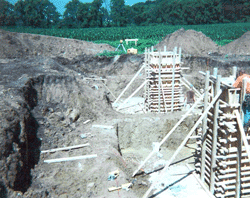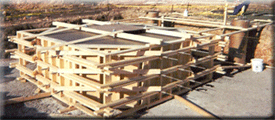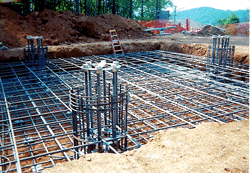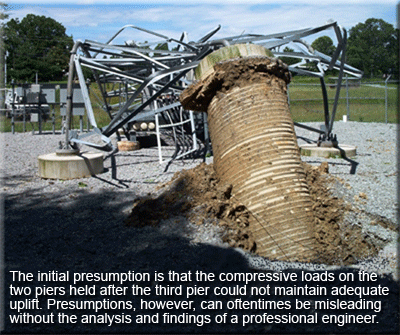|
New soil standard in Rev G replaces vague "normal soil" guideline
Over the years, many towers have been installed throughout the country, with foundation designs that were based on "normal soil" parameters taken from the TIA/EIA 222 F standard and without the benefit of soil borings to identify actual conditions at the site.
Stamped drawings have been approved by building authorities without due regard for the actual soil properties at the site.  Unfortunately, the error of this approach isn't obvious until such time as the catastrophic collapse of the tower exposes the faulty design. Unfortunately, the error of this approach isn't obvious until such time as the catastrophic collapse of the tower exposes the faulty design.
When proper soil characteristics were not available at the time of bid preparation, the Structural Standard for Antenna Supporting Structures and Antennas made reference to a "normal soil" to facilitate foundation and anchor designs for bidding purposes. However, in the the Revision G standard, the technical committee took the position that the use of a term such as "normal soil" is not appropriate, and introduced the notion of presumptive soil parameters.
Default soil is now clay
The standard provides, in an annex, values that are representative of two very common soil types: clay and sand. If the client does not specify the soil type, the default value of clay is to be used for bidding purposes.
The presumptive clay soils are assumed to be non-expansive with a plasticity index of less than 24. The Revision G presumptive soil parameters shown in the table below assume dry conditions (non buoyant) with a soil electrical resistivity greater than 150 ohm-m and a soil pH value of between 3 and 9.
When the site location is unknown, the standard requires that a frost depth of 36 inches be used. It is required by TIA/EIA-222-G that all foundation design parameters and assumptions be validated for the specific site prior to construction.
|
Presumptive Soil Parameters
|
Soil
Type
|
N
(blows/ft)
[blows/m]
|
φ
(deg)
|
γ
( lb/ft3 )
[kN/m3 ]
|
c
(psf)
[kPa]
|
Ultimate
Bearing
(psf)
[kPa]
|
Sf
(psf)
[kPa]
|
k
(pci)
[kN/m3 ]
|
ε50
|
|
Shallow
Fnds.
|
Deep
Fnds.
|
|
Clay
|
8
[26]
|
0
|
110
[17]
|
1000
[48]
|
5000
[240]
|
9000
[431]
|
500
[24]
|
150
[41,000]
|
.01
|
|
Sand
|
10
[33]
|
30
|
110
[17]
|
0
|
3000
[144]
|
7000
[335]
|
500
[24]
|
35
[9,500]
|
N/A
|
Shallow Foundations are detailed as isolated foundations such as pier and pads and mats.
Deep Foundations are drilled piers, piles, and drill and bell foundations.
N = standard penetration value
φ = angle of internal friction
γ = effective unit weight of soil
c = cohesion
Sf = ultimate skin friction
k = lateral modulus of soil reaction
ε50 = strain at 50% of ultimate compression
Actual soil design parameters based on a geotechnical report with similar standard penetration values may vary from the tabulated values.
|
"The best practice, however, is to have the customer provide a geotechnical report along with the bid documents. It’s an expense that will eventually be incurred by the client, and can improve the bid proposals and overall project by allowing the designer to address all the foundation design issues at the start," cautions Simon Weisman, President of Weisman Consultants Inc., an engineering firm that has been specializing in tower analysis and consulting since 1980.
Seldom will you find “normal soil”
When soil borings and reports are not available at the time of bidding, clients frequently request that the contractor use “normal soil” for designing the structure’s foundations. If foundation designs are requested along with the proposal, a contractor that is knowledgeable of local soil conditions can use this to his advantage, knowing that existing conditions will require a smaller foundation than the one based on normal soil.
Without local knowledge, contractors were required to design the foundation using the EIA Normal Soil parameters to determining the lateral load capacities, bearing load capacities and resistance to pull-out.
 TIA/EIA 222 F describes "Normal Soil" as “A cohesive soil with an allowable net vertical bearing capacity of 4000 pounds per square foot (192 kPa) and capable of developing a net horizontal pressure of 400 pounds per square foot per lineal foot of depth (63 kPa per lineal meter of depth) up to a maximum of 4000 pounds per square foot (192 kPa). Note: Rock, noncohesive soils, saturated or submerged soils are not considered normal soil. TIA/EIA 222 F describes "Normal Soil" as “A cohesive soil with an allowable net vertical bearing capacity of 4000 pounds per square foot (192 kPa) and capable of developing a net horizontal pressure of 400 pounds per square foot per lineal foot of depth (63 kPa per lineal meter of depth) up to a maximum of 4000 pounds per square foot (192 kPa). Note: Rock, noncohesive soils, saturated or submerged soils are not considered normal soil.
"There is often a pricing conflict when sites are bid with 'normal soil' foundations. If the actual soil conditions are different from those assumed in the design based on normal soil – and most often they will be – the pricing will no longer be affected by the need of the contractor to remain competitive," explained Weisman.
The design may also be limited by the skills and experience of the contractor, as the purchaser will no longer have access to the ideas of the other contractors. A tower's foundation can represent up to 40% or more of the cost of the structure and its erection expense.
 This information only serves as a snapshot of part of ANSI/TIA/EIA222-G. A copy of the standard can be obtained through www.tiaonline.org . It's a wise investment for companies that earn their living from the design, manufacture, erection and maintenance of communications towers as well as for those who purchase towers. This information only serves as a snapshot of part of ANSI/TIA/EIA222-G. A copy of the standard can be obtained through www.tiaonline.org . It's a wise investment for companies that earn their living from the design, manufacture, erection and maintenance of communications towers as well as for those who purchase towers.
For geotechnical and foundation design professionals and additional information, please view foundation contractors.
Copyright © Wireless Estimator, Inc. Please request reprint permission.
WARNING: This generic, non-exhaustive overview is intended to serve as a useful starting point for research and analysis of the topics addressed. Proper training, professional knowledge and oftentimes licensing are required prior to anyone providing product design, selection, installation, and construction/development-related activities. This information is neither presented to instruct nor teach anyone in the proper or safe methods of any aspect of wireless design or construction. To ensure minimum exposure and to determine compliance for a safe working environment, you must obtain the advice and guidance of an industry professional.

Failure to meet these minimum requirements and appropriate compliance responsibilities can result in serious injury or death to you or your fellow workers. All aspects of wireless construction are hazardous by nature. You have the sole responsibility to act safely and with caution prior to performing any construction-related task. your fellow workers. All aspects of wireless construction are hazardous by nature. You have the sole responsibility to act safely and with caution prior to performing any construction-related task.
Updated: 1.20.2015
|